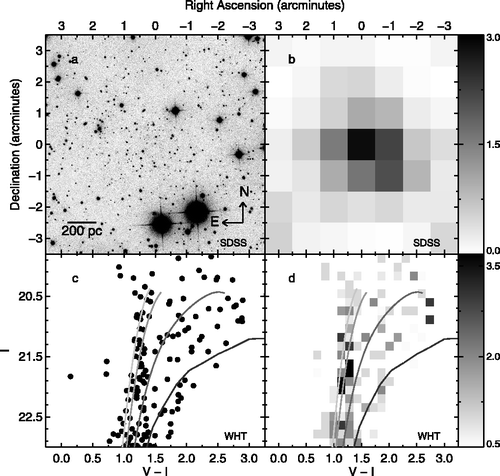 | |||
|
| Home > Public Information > Scientific Highlights > 2007 > Andromeda X: A New Dwarf Spheroidal Satellite of M31 |
Andromeda X: A New Dwarf Spheroidal Satellite of M31 | ||
|
WHT+PFIP
In hierarchical cold dark matter (CDM) models, large galaxies like the Milky Way and M31 form from the merger and accretion of smaller systems. Such models, while successful at large scales, predict at least 1–2 orders of magnitude more low-mass
dark subhalos at the present epoch than the observed abundance of dwarf galaxies. This discrepancy, the “missing satellite” problem, is one of the most serious obstacles for matching CDM theory to observations.
A number of solutions have been proposed to address the problem, at least qualitatively. These range from the possibility that small galaxies somehow inhibit star formation, making them essentially invisible, to the prospect that they are surrounded by more unseen dark matter than first thought. All of these solutions aim to resolve the discrepancy between theory and observation by creating models that predict fewer directly observable satellites. A complementary observational approach would be to place more stringent constraints on the faint end of the galaxy luminosity function, but attempts to do so are hampered by the low surface brightnesses expected of galaxies in that regime. The advent of wide-field CCD surveys such as the Sloan Digital Sky Survey (SDSS) has made it possible to detect stellar structures with extremely low surface brightnesses, and in 2004 astronomers discovered the two faintest galaxies ever seen – UMajor around our Milky Way and Andromeda IX (And IX) around our nearest large galactic neighbour, Andromeda. These finds suggested the missing satellite problem may actually be less dire than originally thought. Since the discovery of And IX, astronomers have been using SDSS photometry of M31 and its surroundings to identify possible M31 companions for deeper observations on other telescopes. Using data from PFIP on the WHT, a team of astronomers reported the discovery of a new dwarf spheroidal companion to M31, Andromeda X (And X), one comparable in luminosity to And IX. They estimated its distance and other physical properties, and found that And X has a dereddened central surface brightness of μV,0~26.7 mag arcsec-2 and a total apparent magintude of Vtot ~16.1, which at the derived distance modulus (m-M)0~24.12–24,34, yields an absolute magnitude of MV~-8.1±0.5. These values are quite comparable to those of And IX.
And X is comparable in size, surface brightness, and apparent magnitude to And IX, and, despite the uncertainty in its distance, And X appears to be somewhat lower in luminosity. So astronomers concluded that And X is a new extremely faint dSph companion of M31. The earlier discovery of And IX raised the question of whether such low-luminosity galaxies were a rarity in the Local Group or whether And IX was the tip of an iceberg, one of a large population of faint satellites that have thus far remained undetected. And X's discovery, along with the recent discoveries of numerous other faint dwarfs around the Milky Way and M31, suggests that the latter scenario is closer to the truth—that M31 and the Milky Way have a large number of low-luminosity satellites.
|
| Top | Back |
|


